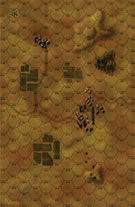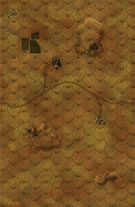|
Watching Those Old Raindrops Fall South Flank #36 |
||
|---|---|---|
| (Defender) Germany | vs | Soviet Union (Attacker) |
| Formations Involved | ||
|---|---|---|
| Germany |  |
1st SS "Leibstandarte Adolf Hitler" Division |
| Germany |  |
LSSAH Reconnaissance Battalion |
| Soviet Union |  |
29th Tank Corps |
| Soviet Union |  |
9th Guards Airborne Division |

|
| Overall Rating, 5 votes |
|---|
|
4.2
|
| Scenario Rank: 38 of 940 |
| Parent Game | South Flank |
|---|---|
| Historicity | Historical |
| Date | 1943-07-12 |
| Start Time | 17:00 |
| Turn Count | 16 |
| Visibility | Day |
| Counters | 93 |
| Net Morale | 1 |
| Net Initiative | 2 |
| Maps | 2: 38, 39 |
| Layout Dimensions | 56 x 43 cm 22 x 17 in |
| Play Bounty | 145 |
| AAR Bounty | 165 |
| Total Plays | 3 |
| Total AARs | 2 |
| Battle Types |
|---|
| Hill Control |
| Inflict Enemy Casualties |
| Urban Assault |
| Conditions |
|---|
| Off-board Artillery |
| Reinforcements |
| Severe Weather |
| Scenario Requirements & Playability | |
|---|---|
| South Flank | Base Game |
| Introduction |
|---|
|
Elements of the Red Army’s 29th Tank Corps rolled over the German recon detachment sent to stop them, and continued on unmolested towards the Komsomolets State Farm. Just before reaching their goal they surprised some artillery batteries that quickly took up the challenge. |
| Conclusion |
|---|
|
Upon breaking though the German recon battalion’s positions, 53rd Motorized Rifle Brigade raced southward. This much is agreed upon by both sides. German sources speak of driving the intruders back northward while Soviet sources claim increasing heavy rain made a withdrawal to more secure positions advisable. That explanation doesn’t ring true, as it seems strange to just abandon hard-won positions due to rain. |
| AFV Rules Pertaining to this Scenario's Order of Battle |
|---|
|
| 3 Errata Items | |
|---|---|

|
All SS 105mm guns should have white, indirect fire values. (Shad
on 2010 Dec 15)
|

|
The reduced direct fire value of the SS HMG is 5-5 in Beyond Normandy and Road to Berlin. (plloyd1010
on 2015 Jul 31)
|

|
The reduced direct fire value in Kursk: Burning Tigers is 4-4. (plloyd1010
on 2015 Jul 31)
|
| Kursk South Flank, scenario #36: Watching Those Old Raindrops Fall | ||||||||||||
|---|---|---|---|---|---|---|---|---|---|---|---|---|
A smaller size two map scenario loaded with a variety of unit types and interesting victory conditions. Also the visibility will change at some point. The Germans have to setup one small group of units forward on the map 39 larger hill hexes which includes the Grille German 150mm SP and some Infantry units. The rest of the Germans setup back on map 38 in the larger town hexes and a third group will start rolling on turn 3 to enter the battle on the east edge of map 38. The larger hill hexes on map 39 and the larger town hexes on map 38 and eliminated enemy steps count as the victory points with each side being reward some different points for each. The Soviets enter their whole force on the north map edge on turn one. Like I said before there are an interesting mix of unit types on both sides. The Soviet run into the smaller dug-in German force on the Hills on map 39 and detaches their lighter T-70 tanks and some infantry to handle the situation. Unfortunately for the Germans, they had to use the 150mm SP as an AT gun instead of using the large direct fire against infantry. The Soviet trade a T-70 unit for a German 150mm Grille SP unit as there were too many T-70’s. The Soviet also at some point gain control of all the larger hill hexes on map 39 but as they started to engage the Germans on map 38 for control of the large town, the Germans rolled very well and their reinforcements arrive on turn 3. No luck for the Soviets, as they can’t hold off the reinforcements and assault the larger town hexes without dividing their forces, not to mention still having units to control the hill hexes up north. They did attempt it but started taking too many casualties. The Game ended with the Soviets controlling the hills on map 39 and the Germans controlling all but one of the larger town hexes on map 38. The Soviet lost 24 steps and the Germans lost 16 but the total victory points figured 26 for the Soviets and 36 for the Germans giving the Germans a Major Victory. Had the Germans not received their reinforcements so early, on turn number 3, it would have been a much closer contest and it could have gone either way. It would have been very interesting but even without this it was a very interest puzzle of a scenario to play. |
||||||||||||
| 0 Comments |
| A Sloppy, Rainy, Lucky Victory | ||||||||||||||
|---|---|---|---|---|---|---|---|---|---|---|---|---|---|---|
The rain was actually the decisive element in this scenario. The reduced visibility took away many of the German advantages (especially for the armor) and meant that the fighting had to be close up and dirty. As the Soviet, I advanced onto the board and went for the victory point locations on the hill. Strangely, the German infantry and Marder all chose to die there, or at least nearby, rather than to retreat and continue the fight elsewhere. I had quite a time mopping up the German infantry, and had a few demoralized pieces that never got back into the game! By about turn seven or eight the Soviets had a line of troops almost but not quite up against a line of troops that the Germans had rushed into formation exactly where the two boards met. And then the rain started... The Soviets did nothing elegant to win this one. There were a few lucky rolls involving assaults that cost the Germans more than they wanted. The Russians were almost rolled-up on their right flank by the Germans at around turn 12 or 13, but this left the German center bare; Russian T-34s were able to plow through the fields and by turn 14 were positioned to take at least two or three town hexes from the Germans. The Germans conceded. |
||||||||||||||
| 0 Comments |

 KurS035
KurS035 





































